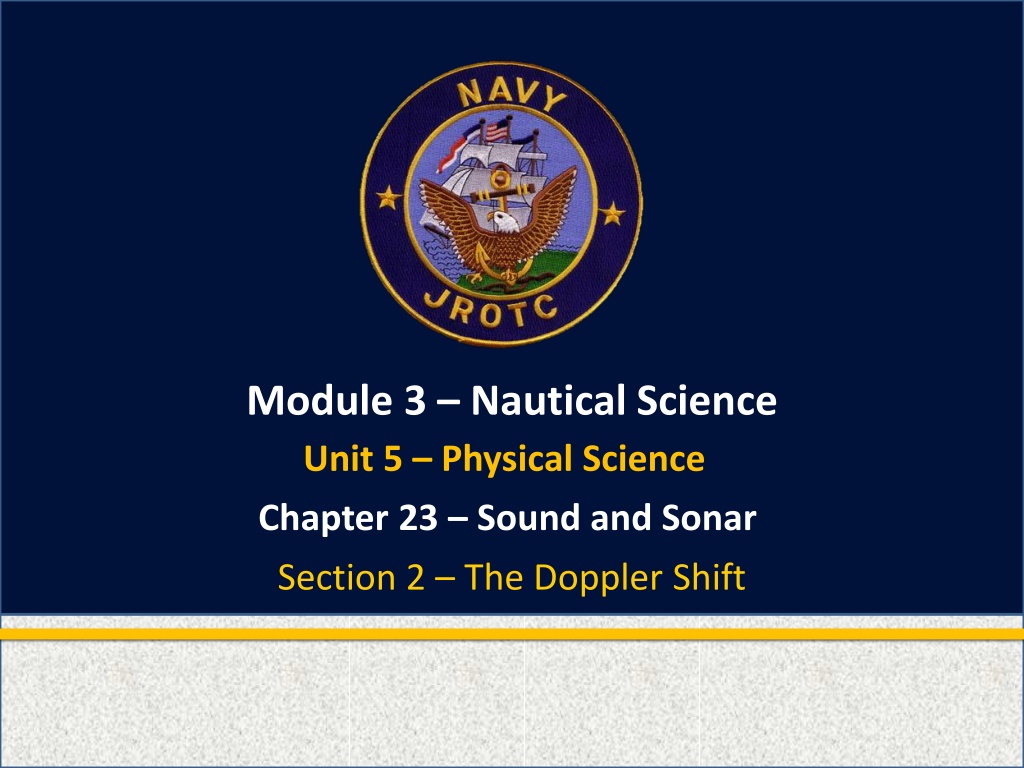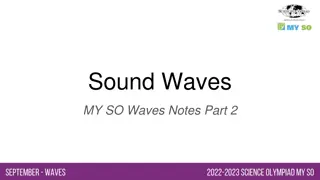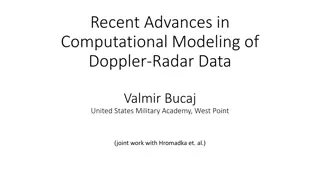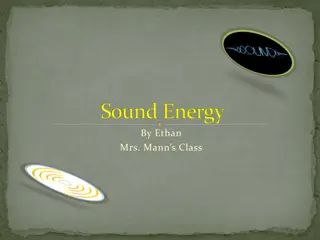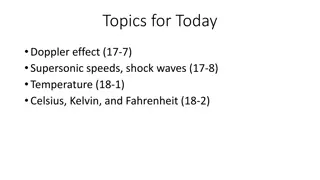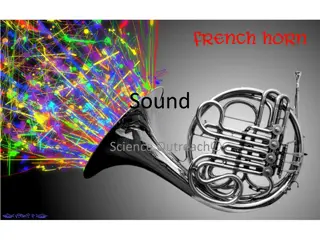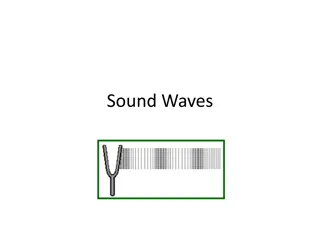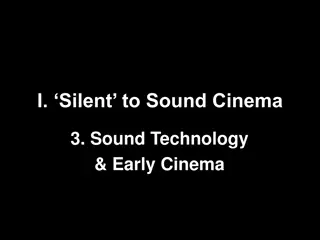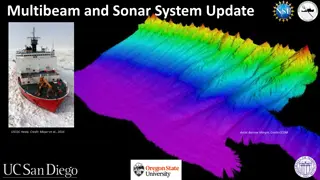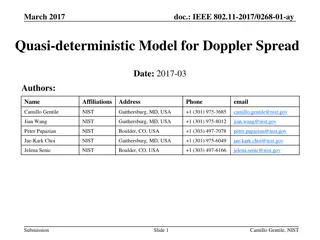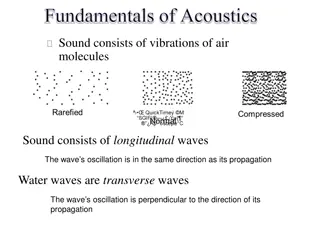Understanding Sound and Sonar: Exploring Doppler Shift in Physical Science
Explore the principles of sound, Doppler shift, and sonar in nautical science. Learn about the characteristics of sound in seawater, the Doppler effect, and how sonar technology is used in detecting underwater objects. Key terms like fathometer, fish finder, hydrophone, active sonar, and passive sonar are explained in detail. Dive into the world of underwater acoustics and gain insights into the fascinating realm of sound waves in the ocean.
Download Presentation

Please find below an Image/Link to download the presentation.
The content on the website is provided AS IS for your information and personal use only. It may not be sold, licensed, or shared on other websites without obtaining consent from the author. Download presentation by click this link. If you encounter any issues during the download, it is possible that the publisher has removed the file from their server.
E N D
Presentation Transcript
Module 3 Nautical Science Unit 5 Physical Science Chapter 23 Sound and Sonar Section 2 The Doppler Shift
What You Will Learn to Do Demonstrate an understanding of Physical Science
Objectives 1. Describe the Doppler shift 2. Explain the characteristics of sound in seawater 3. Describe sonar and its characteristics
Key Terms CPS Key Term Questions 1 - 8
Key Terms Fathometer - A sonar instrument that uses echolocation to measure depths under water A type of fathometer used by fishermen to locate schools of fish beneath their boat; the fish-finder screen displays water depth, echoes returned from fish Fish finder -
Key Terms Doppler effect - A change in the frequency with which waves (as sound or light) from a given source reach an observer when the source and the observer are in motion with respect to each other so that the frequency increases or decreases according to the speed at which the distance is decreasing or increasing
Key Terms Doppler shift - The change between the highest and lowest frequencies heard and the source frequency is called the Doppler shift; it can be used to determine the speed and direction of motion of a sound s source, such as a submarine in the ocean Hydrophone - An instrument for listening to sound transmitted through water
Key Terms Active sonar - The transmission of underwater sound pulses that strike targets and return in the form of echoes Passive sonar - Receive-only mode of operation to receive noise transmitted or caused by targets Sonobuoy - A buoy equipped for detecting underwater sounds and transmitting them by radio
Opening Question Discuss and explain the Doppler Shift. (Use CPS Pick a Student for this question.)
Warm Up Questions CPS Lesson Questions 1 - 2
The Doppler Shift You may have noticed the apparent change in frequency or pitch of a train whistle or automobile horn as the train or auto approaches, passes, and departs.
The Doppler Shift In fact, there is no change in the frequency emitted by the source. There is, however, a change in the frequency reaching the ear, because of the relative motion between the source and you.
The Doppler Shift As the train or auto approaches or moves closer, the effect is an increase in frequency caused by compression of the distance between waves. When the source is opposite you, you hear the same frequency as the whistle or horn puts out.
The Doppler Shift When the train or auto moves away, the effect is to increase the distance between waves, thus causing a decrease in the frequency reaching your ear.
The Doppler Shift This phenomenon is known as the Doppler Effect, named for the Austrian physicist Christian Doppler. Christian Doppler (1803 1853)
The Doppler Shift The total change between the highest and lowest frequencies heard and the source frequency is called the Doppler shift.
The Doppler Shift The Doppler shift can be used to determine the speed and direction of motion of a sound's source, such as a submarine in the ocean. Doppler shifts also occur with electromagnetic waves such as radio and light. Shift
The Doppler Shift By analyzing the Doppler shift in light from a distant star, for instance, astronomers can determine its speed and distance from us. Radar detectors use the Doppler shift to determine the speed of baseballs and automobiles.
Sound in the Sea Since Navy ships and submarines operate in the sea, the characteristics of sound in seawater are of special interest to the Navy.
Sound in the Sea The speed of sound waves traveling through the water is affected by three conditions of seawater: Temperature Pressure, a function of depth Salinity, or salt content
Sound in the Sea Temperature is by far the most important of the factors affecting the speed of sound in seawater.
Sound in the Sea Degree of Temperature Increase The speed of sound changes from 4 to 8 feet per second for every degree of temperature change.
Sound in the Sea The temperature of the sea varies from freezing in the polar seas to more than 85 F in the tropics.
Check on Learning Questions CPS Lesson Questions 3 - 4
Sound in the Sea 0 Water Temperature 60 30 450 Temperature may decrease by more than 30 from the surface to a depth of 450 feet.
Sound in the Sea 85 F S O U N D 45 F Temperature changes in the sea have a great effect on the speed of sound in the seawater.
Sound in the Sea Effect of Pressure on Sound Travel in Water 0 (14.7 psi) Slower 33 (29.4 psi) 66 (44.1 psi) Faster Pressure increases as depth increases, so the deeper a sound wave is, the faster it travels.
Sound in the Sea Seawater has high mineral content or salinity.
Sound in the Sea Density Seawater = 64 lbs per cubic foot Freshwater = 62.4 lbs per cubic foot The density of seawater (due to salt content) is about 64 pounds per cubic foot; that of fresh water is only about 62.4 pounds per cubic foot.
Sound in the Sea High Salinity S O U N D Low Salinity The saltier the water, the greater its density, and hence the faster the speed of sound in it.
Sound in the Sea High Salinity (18 ppt) S O U N D Low Salinity(10 ppt) The speed of sound increases about 4 feet per second for each part-per-thousand increase in salinity.
Sound in the Sea Effect on Sound Travel in Water Salinity Temperature Pressure Salinity has a lesser effect than that of temperature, but greater than that of pressure.
Sonar SOund Navigation And Ranging The principal means of detecting and tracking submarines at sea is called SONAR.
Sonar The earliest sonar device, used in WW I, was a hydrophone lowered into the water to listen for submarines.
Sonar Three hydrophones could pinpoint the location of a submarine by triangulation. Hydrophone Triangulation Fix
Sonar Today's sophisticated sonar equipment can provide highly accurate ranges and bearings to submerged submarines.
Sonar Analysis of Doppler data provides accurate course and speed for a submarine.
Sonar Sonar information is normally presented visually on a CRT screen rather than by sound, as the early devices did.
Check on Learning Questions CPS Lesson Questions 5 - 6
Sonar Sophisticated sonar equipment for use by helicopters and fixed- wing aircraft have also been developed. Two basic modes of operation for sonar systems can be used to detect targets. They are Active and Passive
Sonar The returned echoes from active sonar indicate the range and bearing of the target. When seeking out submarines, ships usually employ the active (pinging) mode.
Sonar Active sonar is also used by submarines and ships to analyze shorelines, bottom characteristics, and ocean depths.
Sonar Although submarines can use active sonar, they rarely do to avoid revealing their position. Passive sonars do not transmit sound.
Sonar Passive sonars listen for sounds produced by the target to obtain accurate bearing and estimated range information.
Sonar Target detection is achieved at great ranges through the use of highly sensitive hydrophones.
Sonar The passive sonar mode is most often used by submarines, although surface ships also have the capability.
Sonar Submarines use passive sonar to analyze the noise of passing ships. Undersea Warfare (USW) aircraft, helicopters, and shore stations also use passive sonar.
Sonar USS Cole (DDG 67) Some sonar systems are mounted in domes below the ship s bow.
Sonar Passive sonar systems, called a towed array, are used on USW surface ships and submarines. A towed array consists of a semi- buoyant tube several thousand feet or more long fitted with numerous hydrophones.
